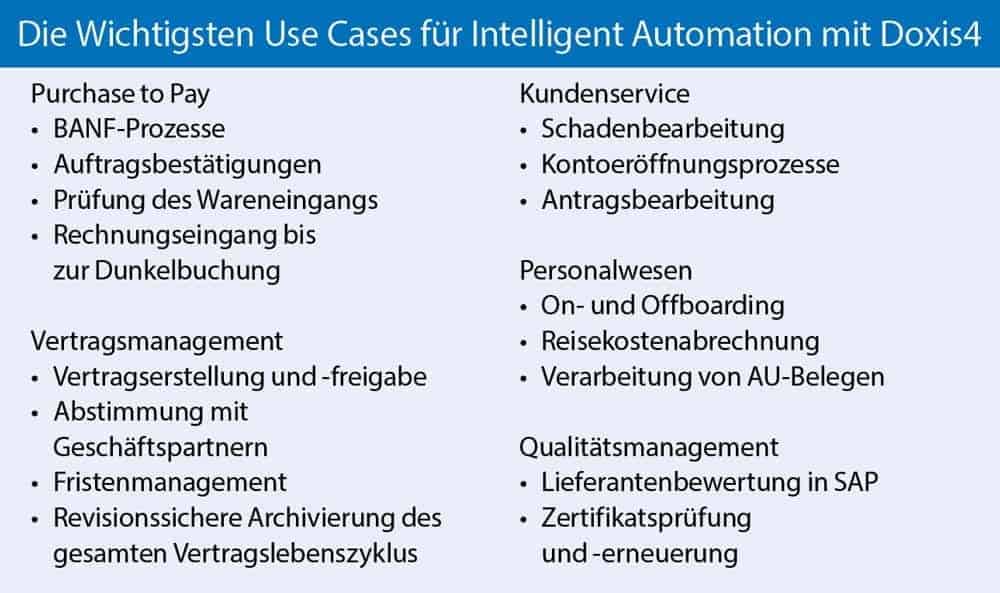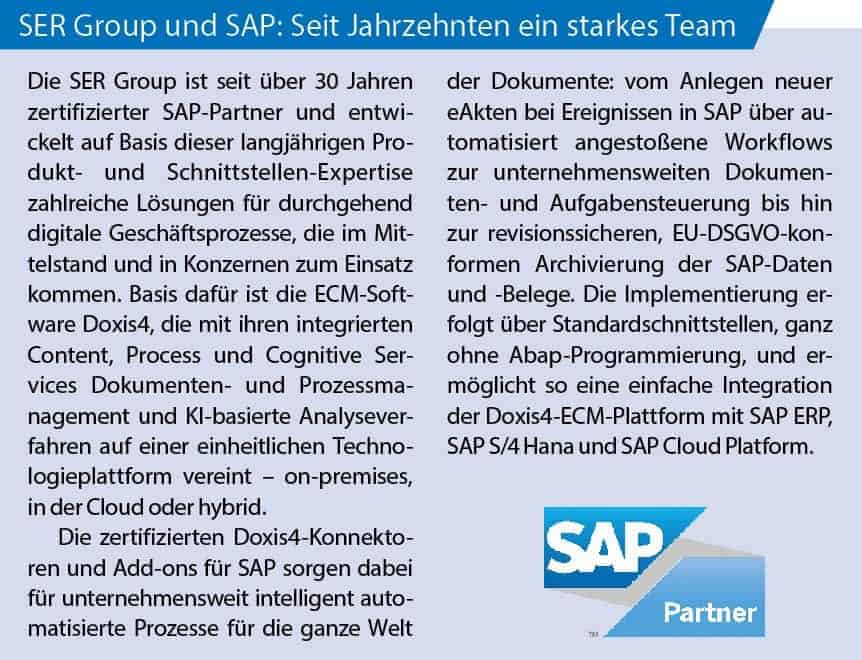Solving the digitization Rubik's Cube sustainably
![[shutterstock.com: 444529351, olalana]](https://e3mag.com/wp-content/uploads/2020/08/shutterstock_444529351.jpg)

Do you remember the motto of the DSAG Technology Days this spring? "Digitization has many sides. It's all about the right twist," postulated the German SAP user community, drawing on the image of the Rubik's Cube as a comparison. Looking back over the past few months, however, it has become clear that many companies still have a long way to go before they get the hang of digitization.
In some places, missing or inadequate digital solutions have suddenly brought business to a standstill: employees are sitting in their home offices without access to documents and SAP data, and business processes have been left at a standstill for the time being. This has an impact on the company's success, which is already groaning under the precarious overall economic situation.
The bill comes at the end of the year at the latest: According to a recent member survey by the Bundesverband Digitale Wirtschaft (BVDW) e. V. (German Digital Industry Association), 98 percent of the digital experts surveyed expect corona-related revenue losses of 32 percent on average for the current year. Sales losses that must be actively countered.
What leads to the goal here is the same as with the Rubik Cube: companies need intelligent strategies and solutions for digitizing their information and processes. Digitization must be driven forward, workflows must be optimized, and services must be adapted. And they need to do this in such a way that they not only achieve rapid success now, but can also withstand the pressure to change and create new solutions in the future.
The SAP community has recognized this quite correctly and is focusing at DSAGLIVE in October on the theme "Future with vision! Winning sustainably. If we continue with the digitalization Rubik's Cube, this means that there is not just one solution with monotonous sides that, once turned correctly, stays that way forever. As with the Rubik Cube, which can be combined to create numerous new patterns, companies must now create new, flexible solutions with which they can overcome the crisis sustainably - and do so as intelligently as possible.

Where SAP is smart and where it is not
SAP is already helping companies achieve this goal with its vision of the Intelligent Enterprise. The new ERP is not supposed to just bumble around, but to make work easier for users through intelligent processes. As far as the customer experience is concerned, the perfect "experience" is promised. To achieve this, SAP uses operational data from business operations and so-called experience data, which is intended to further improve the company's "experience" and ensure satisfied, loyal and, above all, willing-to-buy customers. This is a good idea in view of the current revenue losses.
But the customer experience will never work if the intelligent basis in the back office is missing. It's not just about nice conversations with AI chatbots and personalized product suggestions. At the end of the day, customers want their finished contract and expect fast responses to orders or purchase orders. This requires short turnaround times for processing, but also intelligent planning for incoming goods and production. It requires flexible, fast reactions to uncertain delivery conditions, which are currently more subject than ever to fluctuations in the market.
To achieve all this, companies today must create networked collaboration from different locations despite artificially created distances, streamline their processes, and achieve better quality with the same amount of personnel. Automation and AI support are urgently needed for this. SAP also wants to achieve this with its intelligent ERP. However, the focus here remains limited to data-driven processes. But business processes do not only consist of data! They are dominated by documents, a fact that every clerk can tell you a thing or two about. But documents are not SAP's specialty.
This leaves your users with only a half-finished, half-intelligent solution: They cannot automatically route documents and tasks to the right processor, and they receive no support in selecting the right processes, such as the checking principle for a contract release. In SAP, they also have difficulty finding the right documents for a process, not to mention non-SAP documents. They have to take care of deadlines, retention rules and escalation mechanisms themselves.

It is not new that SAP has a problem here. In times of Corona, however, the gap stands out even more. Anyone who wants to turn their digitization magic cube properly with SAP alone faces a fundamental problem: they don't even have all the building blocks yet. At SER Group, we've been aware of this for a long time and provide the missing pieces for document-driven processes in the form of intelligent information management. We are developing our enterprise content management (ECM) platform Doxis4 for this purpose:
With it, companies provide the right information at the right time and in the right process, make it easier for employees to make decisions, and automate time-consuming manual activities. But even companies like Deutsche Bahn that have already made a conscious decision in favor of a combination of intelligent ECM and SAP for precisely this reason have to fight another dragon in addition to the current difficult market conditions: SAP's product strategy.
Brave new cloud world or cloud cuckoo land?
In recent years, SAP has expanded its portfolio through acquisitions. This expands the Group's range of solutions, but at the same time it must also ensure data harmonization. This is the only way to ensure end-to-end automated processes without system discontinuities, in which users have unrestricted access to the various SAP solutions. And only on a "barrier-free" basis can SAP analyze all existing data with artificial intelligence and deliver the promised improvement in experience.
The SAP Cloud Platform, which integrates SAP solutions and third-party applications, is supposed to provide a remedy for the heterogeneous SAP landscape. The problem is that here, too, SAP has done the math without the documents. The previous ArchiveLink interface has even been eliminated. How do SAP users now get their documents into the cloud? How do they get a holistic view of their processes?
The case is similar for the migration to S/4 Hana. Whether as a cloud or on-premises version, no thought has been given to how documents should move with the migration to the latest SAP product generation. No wonder SAP customers are reluctant to make the switch. But complaining won't get anyone anywhere.
A pragmatic solution is needed! And there is one: just as documents used to be transferred between SAP and ECM via ArchiveLink, it is now as easy in the cloud with the Doxis4 SmartBridge for SAP connector. It not only synchronizes documents and data, but also reacts to events in SAP and triggers document-driven processes such as the creation of new files, which bundle SAP data and associated documents in the right context.
That's one less thing to worry about: The documents remain secure. This doesn't just work when moving to the SAP Cloud Platform. With Doxis4, users can work in both the old and the new SAP world: When switching from SAP ERP to SAP S/4 Hana or SAP S/4 Hana Cloud, the ECM simply continues to run and provides documents there without restrictions. Even when changing the design, the ECM works the same with SAP Fiori as with the SAP Classic UI. If that's not sustainable!

In addition to the lack of document support in all SAP generations, there is another point that causes users to frown: the processes. According to the latest DSAG survey, more than half of those who have already dared to make the switch find the processes after the introduction of S/4 more complex than expected. And yet they should be streamlined right now! SAP customers first have to intelligently add the missing building blocks in the digitization magic cube. This does not only apply to processes used by SAP users.
ECM completes the Rubik's Cube
Hand on heart: Which SAP customer has 100 percent SAP penetration in the company? The fact is that SAP is used in individual areas: HCM or now SuccessFactors in HR, FI in accounting, claims management in the claims department, etc. But the customer doesn't care why the call center can't access orders in SAP and can't provide specific information on delivery status. Even departments without SAP access need to have an overall view of business processes and all related information, just as SAP users need to access documents outside of SAP.
In the ideal SAP world, there is no separation between SAP users and non-SAP users. But the reality is different. The bridge between the two is built by an ECM that brings all systems together under a single denominator: the ERP, additional CRM systems, applications in specialist departments as well as e-mail programs, databases and, of course, all applications in which documents are created and stored. Information in these sources can thus all be found via a single source of truth, regardless of system installations and end devices used.

Companies that introduced ECM at a very early stage were initially only interested in this archive function: Documents and data were to be centrally available and stored in an audit-proof manner. However, the days of ECM as a dumb archive in the background are long gone. Of course, there are still "lean" archive solutions that can do nothing else. But they cannot tackle the Rubik's Cube of digitization; they simply lack the intelligence and process automation that are necessary for this.
In addition to ECM Services, ECM systems such as Doxis4 also provide Process Services and Cognitive Services, which enable intelligent, automated information management and thus perfectly complement SAP not only in terms of document management, but also in process management - and in very many areas. Here are a few relevant examples.
The pilot: Invoice
Most companies that already archive their SAP documents in an audit-proof manner with ECM start with automated invoice receipt. This is because SAP is great at posting, but it does not cover the checking and release of invoices. SER Group has developed Doxis4 Intelligent Invoice Automation for this purpose, in which the ECM takes over these steps fully automatically, up to and including dark posting. This saves SAP users manual effort, is much faster and, thanks to AI-based processes, detects discrepancies between orders and invoices or missing invoice items much more accurately than a human.
The decisive factor here is that, in contrast to the much-hyped Robotic Process Automation (RPA), not only data is transferred automatically, but processes with documents and tasks are mapped and controlled. No SAP or RPA solution can do that. Here, companies should not be misled by a trend, but should take a close look at their use case.
Does the process run rigidly and contain data? Then RPA is suitable. Are the processes document-based and need to be adapted or set up quickly? In that case, you need an ECM platform with content and process services. They can be used not only to automate the same processes over and over again, but also to map many other use cases.

Intelligently expanded: P2P
What could be more obvious than automating related processes besides invoice processing? Checking order confirmations and reminders sent by suppliers, but also handling payment notices and any complaints from customers: All this can be mapped with an ECM through automated, AI-supported workflows. A prime example of this is August Storck KG, which will report in its presentation at DSAGLIVE on how it automates its purchase-to-pay and order-to-cash process with Doxis4 Intelligent Automation and SAP.
This not only improves cooperation with suppliers and retailers, it also prevents financial losses and facilitates liquidity planning. As a confectionery manufacturer, Storck is also subject to numerous regulations and must, for example, document the sustainability of raw materials or the safety of input materials: These requirements can also be suitably taken into account with ECM and SAP. The entire P2P and O2C process chain is supported across all areas involved, can be intelligently controlled and flexibly adapted.
Respond faster: Enterprise-wide contract management
Contracts can be found everywhere in the company: with customers, service providers, suppliers, employees, for leasing and renting office buildings. One challenge that companies are facing right now is how to adapt these contracts quickly. New delivery conditions or changed working hours must be incorporated promptly. An ECM such as Doxis4 automates such contract reconciliations and also facilitates contract changes and the associated adherence to notice periods - all prerequisites for companies to be able to react quickly to changing market requirements and not remain shackled to old liabilities.
Intelligence comes into play when, for example, data on contractual partners is transferred from SAP to the contracts quickly and without errors, the creation of master agreements and the filing of contracts in them happen automatically as soon as a new contractual partner is created in SAP, and the correct follow-up processes, such as purchase orders, are triggered after the contract is concluded.

Winning and retaining customers: Automation in service
Just a few years ago, many companies would have cited cost reduction and process efficiency as the main reasons for automation. Today, they are increasingly recognizing that automated processes can, above all, help them better utilize employees, support them in decisions such as risk assessment of new customers, and thus improve their response time in customer service. Insurance companies such as DEVK are a classic example of this. On the one hand, it uses SAP Claims Management for settlements and archives the resulting documents with Doxis4.
Wherever documents are the focus, on the other hand, ECM is the leading system. DEVK uses it to digitize and control all incoming documents from the moment they arrive in the mail, to distribute tasks throughout Germany, and to process new applications and contracts, for example. The result makes policyholders and employees happy: The time spent on mail distribution has dropped by 75 percent, and customer concerns are processed on the same day. Such a speed is unimaginable with SAP alone.
Professionals on the job immediately: Automated HR processes
Skilled workers must be recruited even in times of Corona. If only to replace employees who leave the company due to retirement, for example. And, of course, they should be able to work productively as quickly as possible. The Krone Group shows how this can be achieved through workflow-controlled onboarding:
As soon as a new employee is created in SAP, Doxis4 automatically creates the associated personnel file and starts the onboarding workflow. Set up workstation and PC, prepare keycard, prepare access to specialist applications, organize company car, book training: HR, procurement, IT and facility management are automatically notified of what needs to be done and by when. Intelligent automation networks them across areas. This means that no employee has to sit around idly on their first day of work waiting for work materials.

Sustainable wins
The classic Rubik's Cube offers 43 trillion different rotation possibilities. Fortunately, companies do not have to make that many moves in their digitization. But the examples above show how many different ways SAP and an intelligent ECM can be used together. As mentioned, this does not work with every ECM. For intelligent solutions, intelligence must be anchored in the core in such a way that it can be used for all information and processes that are managed with the ECM.
At Doxis4, AI and automation are fixed components of the ECM platform, so that even complex processes can be mapped and intelligently controlled. And for all those who would like to solve the digitization magic cube completely in the cloud, we can tell you that a future-proof ECM also runs there.
SaaS offerings and managed services make the implementation, administration, and maintenance of ECM solutions calculable, ensure that they can be deployed quickly, are scalable, and mesh with SAP solutions right from the start. This creates a networked and at the same time flexible basis on which companies can combine new, intelligent and automated processes again and again - and sustainably solve the digitization Rubik's Cube under current and under future requirements.





